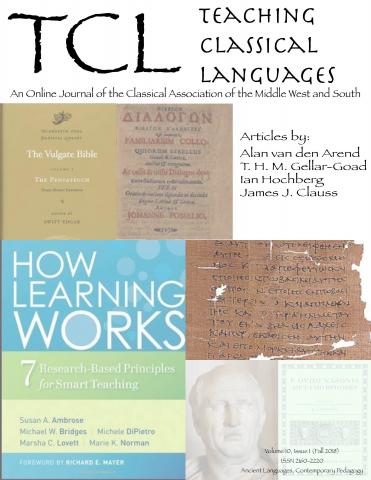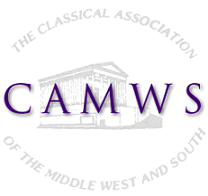Welcome to Teaching Classical Languages (TCL). TCL is the peer-reviewed, online journal dedicated to exploring how we teach (and how we learn) Greek and Latin. TCL is sponsored by the Classical Association of the Middle West and South (CAMWS).
Volume 10 Issue 1

Abstracts of Articles
Something Old, Something New: Marrying Early Modern Latin Pedagogy and Second Language Acquisition (SLA) Theory
Growing interest in ‘active’ Latin has prompted much discussion regarding the role of contemporary Second Language Acquisition (SLA) Theory in Latin instruction. Often framed as a contest between ‘traditional’ (Grammar-Translation) and ‘new’ (SLA-informed) pedagogies, debate in the field has proceeded according to assumptions regarding the relative historicity of both frameworks with little reference to the recorded tradition of Latin teaching practices. In short, present discussions have not been situated in the timeline of actual historical developments. This article attempts to redress this apparent lack of discussion by comparing basic principles of contemporary SLA-informed pedagogy with strategies from educational treatises published between the years 1511 and 1657. It seeks (1) to demonstrate the existence of an early modern Latin pedagogy with principles like those supported by contemporary SLA research, (2) to offer a comparative reading of that pedagogy’s premises with consensus positions of current SLA-informed instruction, and (3) to reflect upon the potential uses of this comparison for present day Latin teaching. This reading is exemplary, targeting one model for Latin pedagogy from the early modern period. Investigation remains necessary to identify both the scope and the depth of this tradition and its potential usefulness for reimagining Latin teaching in the 21st century.
How Learning Works in the Greek and Latin Classroom
This article presents seven neuroscience-based principles of how people learn, derived from Susan Ambrose et al.’s How Learning Works, and offers practical advice and tools for applying these principles to the teaching of Greek and Latin. To teach as best as we can, we should look to how our students learn and to how we can better promote and support their learning. The seven concepts are: [1] novices and experts organize knowledge differently; [2] students’ prior knowledge affects present class performance; [3] learning depends on motivation, a threefold phenomenon; [4] learning is best supported by targeted practice and timely feedback; [5] acquisition of complex skills depends on automaticity in and integration of basic tasks; [6] reflection and metacognition are essential for successful learning; and [7] course environment and student identity development have profound effects on learning effectiveness. Each principle is treated separately with a subsection on relevant language-instruction techniques. The conclusion ties together the ramifications of these principles for pedagogy and for course design. The Appendix presents sample documents.
Quid vultis discere? Crafting a Student-Guided Latin Literature Course
This paper poses a fundamental question: how deeply are our Latin students engaging with Latin literature? How many connections are they making between the literature and their lives? Last summer, I asked myself these questions and crafted a course to increase student choice, breadth of reading, and deeper connections with the material. This paper provides some inspiration for new, simple ways to help students discover for themselves authors such as Ovid, Cicero, Catullus, and Horace. The paper shares project topics relating to Ovid’s works which allow for student choice, creativity, and personal connection. It also highlights successes and difficulties in my attempt to increase student choice and broaden their understanding of these authors. It suggests that incorporating English readings can be an effective strategy to provide context for the Latin and greater breadth of an author’s writing. It reminds us to let go of methods we cling to that may not work for today’s students. The paper emphasizes the importance of constant formal and informal feedback from students. Lastly, the paper explores the joy of reading a new, student-selected Latin passage for the first time together with students and learning alongside them.
Teaching the Old and New Testaments to Students of Greek and Latin Simultaneously with Numerous and Fascinating Learning Outcomes
Because Old and New Testament texts in Greek and Latin are almost word for word replicas of each other inasmuch as they are both translations of preexisting texts, they can be taught simultaneously to students who know only one or both of the languages in the same classroom. Moreover, students with only one year of training can take such a class because of the syntactical simplicity of the texts and repetitive nature of the vocabulary. There are a number of outstanding learning outcomes to expect from teaching these works: critical thinking, introduction to textual criticism, canonicity, the Documentary Hypothesis, translation goals, cultural appropriation, comparative mythology, interdisciplinarity, and ancient biography.

